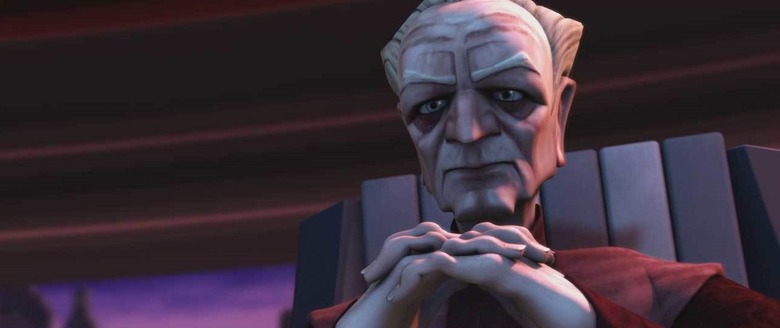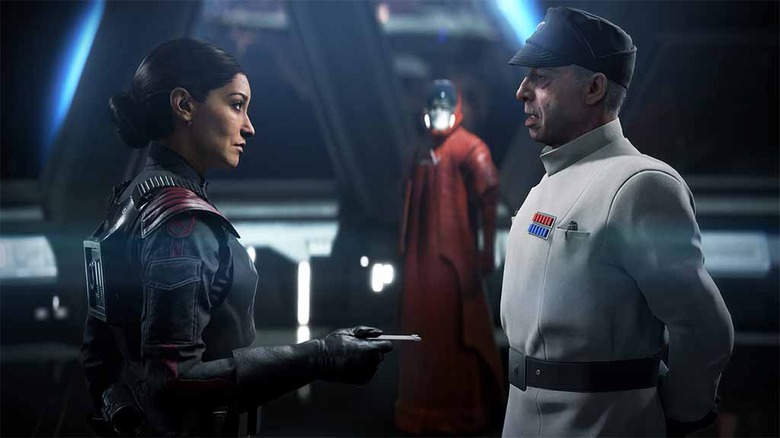The Emperor Reborn: How The 'Star Wars' Prequels And The New Disney Canon Reshape Palpatine
(Welcome to The Emperor Reborn, a three-part series examining the role of Sheev Palpatine and the long shadow he casts over the Skywalker Saga, including the upcoming Star Wars: The Rise of Skywalker.)
In chapter two of The Emperor Reborn, we take a look at the Emperor's role in the prequel trilogy and how he's been expanded in the new, Disney-approved canon.
The Phantom Menace: The Prequel Trilogy
"Everybody believes it's Darth Vader who's the really ultimate bad guy, but the guy who's truly evil is Palpatine. He has manipulated this whole saga." - Rick McCallumWhile it appears in Alan Dean Foster's 1976 novelization, the name Palpatine would not be used in a Star Wars film until 1999's Star Wars: Episode I – The Phantom Menace. In the movie, which is set 32 years before A New Hope, Palpatine – played again by McDiarmid – is a Galactic Senator from the planet Naboo and Darth Sidious, Dark Lord of the Sith and master to apprentice Darth Maul. By manipulating Queen Padmé Amidala and the Trade Federation's Nute Gunray, Sidious orchestrates the invasion of Naboo and uses the conflict to become Supreme Chancellor of the Republic. In 2002's Episode II: Attack of the Clones, set 10 years later, Palpatine manufactures a galactic civil war. His new apprentice, Darth Tyrannus aka Count Dooku, rallies thousands of star systems into declaring independence from the Republic, forming the Confederacy of Independent Systems, with Dooku as its leader. Meanwhile, Palpatine plants the seeds of attachment and possession in Anakin Skywalker by arranging for the young Jedi to serve as bodyguard to Padmé Amidala on Naboo. Away from the Jedi and the Senate, they fall in love and marry, something that is forbidden by the Jedi Order. When it's revealed that the Separatists are amassing forces, Palpatine uses the crisis to seize more power from the Galactic Senate. He is granted emergency wartime powers by Representative Jar Jar Binks and vows to create a Grand Army of the Republic to counter the increasing threats of the Separatists. Begun the Clone War has. 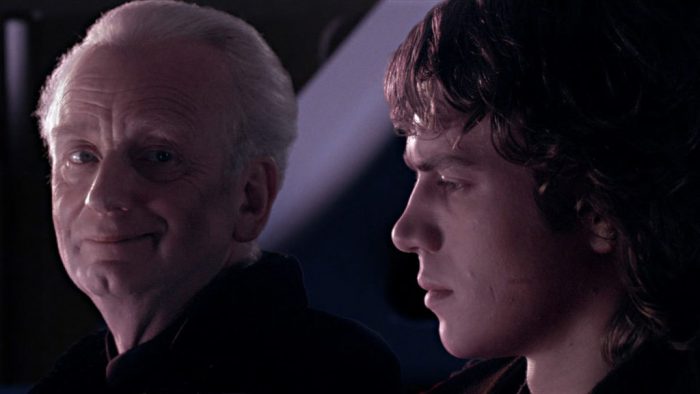 "The dark side of the Force is a pathway to many abilities some consider to be... unnatural." - Supreme Chancellor PalpatineIn 2005's Episode III: Revenge of the Sith, set three years later, Palpatine continues his campaign of corruption by ordering Anakin Skywalker to kill Count Dooku in cold blood. Suspicious of the Jedi, Palpatine appoints Anakin as his representative on the Jedi Council, who deny Anakin the rank of Jedi Master and order him to spy on the Chancellor. Palpatine tells a conflicted Anakin "The Tragedy of Darth Plagueis the Wise," a legend about a Dark Lord of the Sith, so powerful and so wise he could use the Force to influence the midi-chlorians to create life. "He had such a knowledge of the dark side he could even keep the ones he cared about from dying." According to Palpatine, Plagueis taught his apprentice (Sidious) everything, only to be betrayed and murdered by him. Eventually, Palpatine reveals his true identity to Anakin; he knows that Anakin has been having visions of Padmé's death, and offers to teach him dark side secrets to save her life.
"The dark side of the Force is a pathway to many abilities some consider to be... unnatural." - Supreme Chancellor PalpatineIn 2005's Episode III: Revenge of the Sith, set three years later, Palpatine continues his campaign of corruption by ordering Anakin Skywalker to kill Count Dooku in cold blood. Suspicious of the Jedi, Palpatine appoints Anakin as his representative on the Jedi Council, who deny Anakin the rank of Jedi Master and order him to spy on the Chancellor. Palpatine tells a conflicted Anakin "The Tragedy of Darth Plagueis the Wise," a legend about a Dark Lord of the Sith, so powerful and so wise he could use the Force to influence the midi-chlorians to create life. "He had such a knowledge of the dark side he could even keep the ones he cared about from dying." According to Palpatine, Plagueis taught his apprentice (Sidious) everything, only to be betrayed and murdered by him. Eventually, Palpatine reveals his true identity to Anakin; he knows that Anakin has been having visions of Padmé's death, and offers to teach him dark side secrets to save her life.  Anakin pledges himself to the dark side as Palpatine's Sith apprentice, Darth Vader. Palpatine issues Order 66, commanding the Republic's clone army to turn on their Jedi generals while dispatching Vader to kill everyone inside the Jedi Temple and then deal with the Separatist leaders on the planet Mustafar. At last, Palpatine's long con has paid off; the war is over, the Separatists are dead, and the treacherous Jedi are all but extinct. In an address to the Galactic Senate, Palpatine announces that the Republic will be reorganized into a Galactic Empire, to ensure security and continuing stability with himself as Emperor.
Anakin pledges himself to the dark side as Palpatine's Sith apprentice, Darth Vader. Palpatine issues Order 66, commanding the Republic's clone army to turn on their Jedi generals while dispatching Vader to kill everyone inside the Jedi Temple and then deal with the Separatist leaders on the planet Mustafar. At last, Palpatine's long con has paid off; the war is over, the Separatists are dead, and the treacherous Jedi are all but extinct. In an address to the Galactic Senate, Palpatine announces that the Republic will be reorganized into a Galactic Empire, to ensure security and continuing stability with himself as Emperor.
Master of the Dark Arts: The New Canon
On April 25, 2014, after a year of ownership by the Walt Disney Company, Lucasfilm confirmed that the Sequel Trilogy would not adhere to the post–Return of the Jedi Expanded Universe continuity. LucasBooks Senior Editor Jennifer Heddle stated that the EU as a whole would no longer be considered canon and that it would be rebranded as "Legends," with related publications remaining in print under that banner.Now, the Star Wars canon is comprised of the films and television series – Star Wars: The Clone Wars, Star Wars Rebels, Star Wars Resistance – as well as comics, books, and games published after April 25, 2014, as the Lucasfilm Story Group oversees continuity as a whole for the brand. While Dark Empire is no longer canon, there are plenty of new stories that are Palpatine-centric. If you haven't kept up with Star Wars: The Clone Wars or Star Wars Rebels, you might have been a little confused when Darth Maul popped up in Solo: A Star Wars Story. That's because the character survived his encounter with Obi-Wan Kenobi in The Phantom Menace and went on to appear in the animated series. Like his former apprentice, Palpatine has continued to develop as a character throughout the new canon.In Star Wars: The Clone Wars (set between Attack of the Clones and Revenge of the Sith), Palpatine (voiced by Ian Abercrombie from 2008-2012 and Tim Curry from 2012-2014) continues to serve as Supreme Chancellor of the Republic while his Sith identity manipulates both sides of the Clone Wars.Sidious hires bounty hunter Cad Bane to infiltrate the Jedi Temple and steal a holocron containing a list of the galaxy's Force-sensitive children – the very future of the Jedi Order. Sidious wants to bring the younglings to his secret facility on Mustafar and turn them into Sith spies, but his plan is foiled by Anakin Skywalker and his padawan, Ahsoka Tano. Later, Sidious orders Dooku to eliminate Asajj Ventress, as he suspects that his apprentice is planning to have the dark side disciple assassinate him. Ventress survives, and her vendetta against Dooku sets off a chain of events including the return of Sidious' former apprentice, Darth Maul, and his brother, Savage Opress.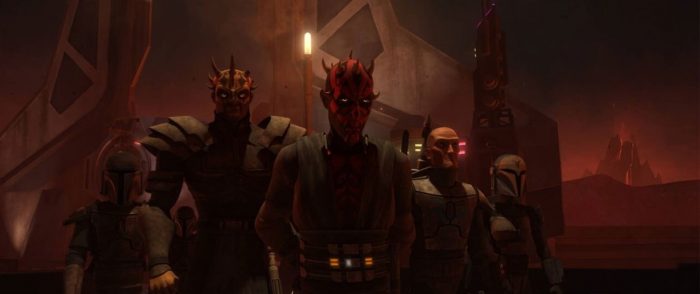 In addition to learning more about Palpatine, The Clone Wars further explored the Force itself, as well as the prophecy of the Chosen One. Obi-Wan Kenobi, Anakin Skywalker, and Ahsoka Tano visit Mortis, an ethereal realm within the Force that's home to three Force wielders locked in an eternal struggle: the Son, who represents the dark side; the Daughter, who represents the light; and the Father, who maintains the balance of the Force between them. In season six, Yoda enters the Valley of the Dark Lords on Moraband – the ancient homeworld of the Sith Order – where he encounters the spirit of Darth Bane, the founder of the Rule of Two. Sensing the Jedi Master's presence, Sidious exploits the Force-bond between Dooku and Yoda and uses Sith sorcery to cast an illusion to deceive and corrupt the Jedi, but his plan ultimately fails. The Emperor also appears in the comic book series Darth Vader: Dark Lord of the Sith by Kieron Gillen and Charles Soule, which suggests that Palpatine manipulated the Force to impregnate Vader's mother, Shmi Skywalker, making him, in essence, Vader's father. While left somewhat ambiguous, Palpatine does say in Revenge of the Sith that his master taught him everything he knew, so it's entirely possible that he could use the Force to influence the midi-chlorians to create life.One of the first four novels published in the franchise after Lucasfilm reset Star Wars continuity, James Luceno's Tarkin features Palpatine prominently. The book, which chronicles Wilhuff Tarkin's rise through the ranks of the Empire and his relationships with the Emperor and Darth Vader, reveals Palpatine's first name — Sheev. Prior to 2014, Palpatine was not given a first name in any canonical or "Star Wars Legends" sources. In Paul S. Kemp's Lords of the Sith, set 14 years before A New Hope, Emperor Palpatine and Vader find themselves stranded on the planet Ryloth. There, they are hunted by an army Twi'lek freedom fighters led by Cham Syndulla, with only their lightsabers, the dark side, and each other to depend on.
In addition to learning more about Palpatine, The Clone Wars further explored the Force itself, as well as the prophecy of the Chosen One. Obi-Wan Kenobi, Anakin Skywalker, and Ahsoka Tano visit Mortis, an ethereal realm within the Force that's home to three Force wielders locked in an eternal struggle: the Son, who represents the dark side; the Daughter, who represents the light; and the Father, who maintains the balance of the Force between them. In season six, Yoda enters the Valley of the Dark Lords on Moraband – the ancient homeworld of the Sith Order – where he encounters the spirit of Darth Bane, the founder of the Rule of Two. Sensing the Jedi Master's presence, Sidious exploits the Force-bond between Dooku and Yoda and uses Sith sorcery to cast an illusion to deceive and corrupt the Jedi, but his plan ultimately fails. The Emperor also appears in the comic book series Darth Vader: Dark Lord of the Sith by Kieron Gillen and Charles Soule, which suggests that Palpatine manipulated the Force to impregnate Vader's mother, Shmi Skywalker, making him, in essence, Vader's father. While left somewhat ambiguous, Palpatine does say in Revenge of the Sith that his master taught him everything he knew, so it's entirely possible that he could use the Force to influence the midi-chlorians to create life.One of the first four novels published in the franchise after Lucasfilm reset Star Wars continuity, James Luceno's Tarkin features Palpatine prominently. The book, which chronicles Wilhuff Tarkin's rise through the ranks of the Empire and his relationships with the Emperor and Darth Vader, reveals Palpatine's first name — Sheev. Prior to 2014, Palpatine was not given a first name in any canonical or "Star Wars Legends" sources. In Paul S. Kemp's Lords of the Sith, set 14 years before A New Hope, Emperor Palpatine and Vader find themselves stranded on the planet Ryloth. There, they are hunted by an army Twi'lek freedom fighters led by Cham Syndulla, with only their lightsabers, the dark side, and each other to depend on.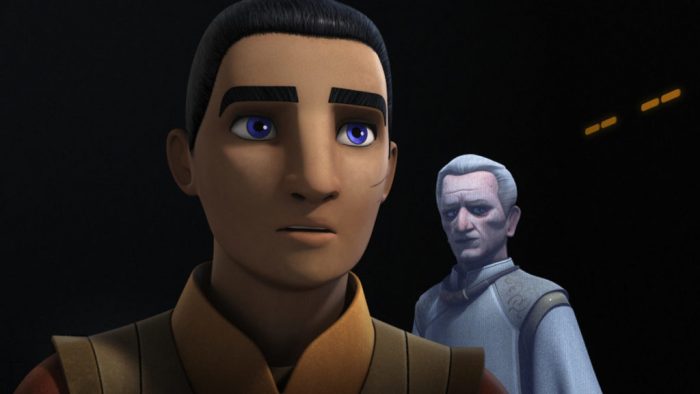 The animated series Star Wars Rebels, set five years before A New Hope, shows the Emperor's obsession with "unlocking" the Jedi Temple on Lothal (which features a painting of the Mortis gods) and entering "The World Between Worlds," a mystical plane that exists between time and space, linking all moments in time together. Using Sith sorcery, the Emperor (voiced by McDiarmid) attempts to seize control of the plane and control the universe, but Ezra Bridger and Ahsoka Tano thwart his plans. In the new canon, there is a precedent for the spirits of Sith to remain bound to the living world through an object or location, corrupting and even possessing those who come into contact with them. In Star Wars: Lando, the Marvel comic miniseries set before The Empire Strikes Back, Lando Calrissian and Lobot steal The Imperialis, the Emperor's luxury pleasure yacht, in hopes of selling off the ship's treasures. Inside the vessel's central chamber, the scoundrel discovers several Sith artifacts, including the Mask of Lord Momlin, a helmet created by the Sith Lord and sculptor, Lord Momin. Momlin, like Palpatine's former master, believed in achieving power through creation, rather than destruction. His helmet could not only corrupt and control individuals but communicate with them as well. In the miniseries, Momlin's mask possesses members of Calrissian's crew, forcing the smuggler to abandon the ship and set it for self-destruct.
The animated series Star Wars Rebels, set five years before A New Hope, shows the Emperor's obsession with "unlocking" the Jedi Temple on Lothal (which features a painting of the Mortis gods) and entering "The World Between Worlds," a mystical plane that exists between time and space, linking all moments in time together. Using Sith sorcery, the Emperor (voiced by McDiarmid) attempts to seize control of the plane and control the universe, but Ezra Bridger and Ahsoka Tano thwart his plans. In the new canon, there is a precedent for the spirits of Sith to remain bound to the living world through an object or location, corrupting and even possessing those who come into contact with them. In Star Wars: Lando, the Marvel comic miniseries set before The Empire Strikes Back, Lando Calrissian and Lobot steal The Imperialis, the Emperor's luxury pleasure yacht, in hopes of selling off the ship's treasures. Inside the vessel's central chamber, the scoundrel discovers several Sith artifacts, including the Mask of Lord Momlin, a helmet created by the Sith Lord and sculptor, Lord Momin. Momlin, like Palpatine's former master, believed in achieving power through creation, rather than destruction. His helmet could not only corrupt and control individuals but communicate with them as well. In the miniseries, Momlin's mask possesses members of Calrissian's crew, forcing the smuggler to abandon the ship and set it for self-destruct.
The Contingency
Set immediately after the events of Return of the Jedi, both the Star Wars: Aftermath series of books and the video game, Star Wars: Battlefront II, explore the Emperor's contingency plan. Before his untimely demise, Palpatine creates the Contingency to dismantle the Galactic Empire in the event of his death. The Empire, he believes, does not deserve to survive without its Emperor.Thirty years before the Battle of Yavin, while Supreme Chancellor of the Galactic Republic, Palpatine initiates the construction of an Observatory on the remote desert planet of Jakku. Built over a borehole that leads directly to the planet's core, the facility houses a replica of the Imperialis and many Sith relics and artifacts.The Jakku Observatory plays a vital role in the Emperor's contingency plan. After the Battle of Endor, Palpatine's protégé, Gallius Rax, assumes control of the Empire and concentrates its remaining forces on Jakku. There, the Empire makes its last stand against the New Republic.During the Battle of Jakku, Rax and Yupe Tashu pour Sith relics down the borehole to detonate Jakku's core and trigger a cataclysm. Tashu, a Sith historian and one of Palpatine's closest advisers, is convinced that the Emperor isn't dead and that they will find him in the Unknown Regions."Palpatine lives on. We will find him again out there in the dark. Everything has arranged itself as our master foretold. All things move toward the grand design." - Yupe TashuIn Chuck Wendig's Aftermath, Tashu mentions that some Sith Lords were able to siphon the Force from other lifeforms to extend their own lives for centuries beyond their natural expiration. Rax kills Tashu as part of the Contingency, pushing him into the borehole. His plan to destroy Jakku and the forces orbiting it is only partially successful, however. Before Rax can escape off-world with Brendol Hux, his young son Armitage, and their child soldiers aboard the Imperialis, he is killed by Grand Admiral Sloane with the help of Norra Wexley and Brentin Lore Wexley.With Rax dead, Hux and a select number of "worthy" Imperial officers and personnel flee to the Unknown Regions to carry out the final part of the Contingency. There, among the black holes and gravity wells, the Galactic Empire will be reborn as the First Order, with Hux training a new generation of stormtroopers — child conscripts trained from birth and programmed for absolute loyalty.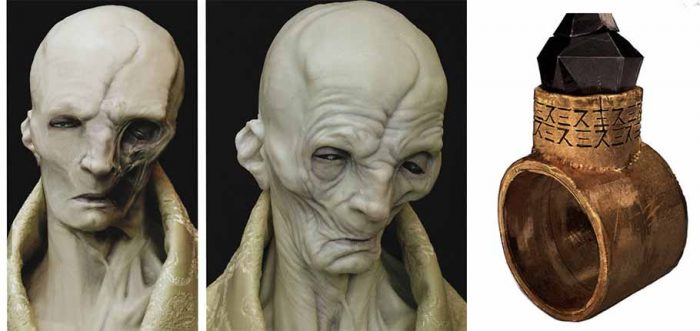 In Palpatine's absence, the First Order is led by Supreme Leader Snoke, a force-sensitive humanoid alien from the Unknown Regions. A master of the dark side of the Force, Snoke is not a member of the Sith but shares their disdain for the Jedi Order. Curiously, he wears a gold ring inscribed with glyphs from the Four Sages of Dwartii, encrusted with obsidian from the Sith cave beneath Fortress Vader on Mustafar. Coincidentally, or perhaps not, Supreme Chancellor Palpatine kept bronzium statues of the Four Sages in his office and chambers on Coruscant. In his pursuit for galactic conquest, Snoke lures Vader's grandson, Ben Solo, away from the Jedi path. As the newly anointed Kylo Ren, Solo all but destroys the Jedi Order, except for his uncle and mentor, Luke Skywalker, who flees into exile as the last Jedi of his time.
In Palpatine's absence, the First Order is led by Supreme Leader Snoke, a force-sensitive humanoid alien from the Unknown Regions. A master of the dark side of the Force, Snoke is not a member of the Sith but shares their disdain for the Jedi Order. Curiously, he wears a gold ring inscribed with glyphs from the Four Sages of Dwartii, encrusted with obsidian from the Sith cave beneath Fortress Vader on Mustafar. Coincidentally, or perhaps not, Supreme Chancellor Palpatine kept bronzium statues of the Four Sages in his office and chambers on Coruscant. In his pursuit for galactic conquest, Snoke lures Vader's grandson, Ben Solo, away from the Jedi path. As the newly anointed Kylo Ren, Solo all but destroys the Jedi Order, except for his uncle and mentor, Luke Skywalker, who flees into exile as the last Jedi of his time.
***
Return tomorrow for the third and final chapter of this series, where we explore Palpatine's influence on the sequel trilogy and beyond.

